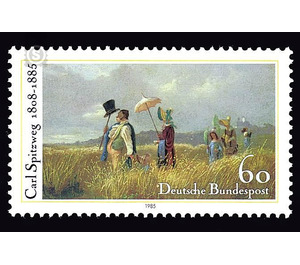100th anniversary of death of Carl Spitzweg - Germany / Federal Republic of Germany 1985 - 60 Pfennig
Theme: Art & Culture
| Country | Germany / Federal Republic of Germany |
| Issue Date | 1985 |
| Face Value | 60.00 |
| Color | multi-colored |
| Perforation | K 14 |
| Printing Type | Six-color offset printing |
| Stamp Type | Postage stamp |
| Item Type | Stamp |
| Chronological Issue Number | 1131 |
| Chronological Chapter | GER-BRD |
| Michel ID | BRD 1258 |
| SID | 837510 |
| In 44 Wishlists | |
Carl Spitzweg died 100 years ago, on September 23, 1885, after suffering a stroke in his flat at Heumarkt in Munich. He is associated with the image of a humorous, even quirky painter who portrayed his surroundings in a petit-bourgeois idyll. Especially in the twentieth century he gained in popularity and was often misunderstood as an uncritical painter of the German philistine. Born on 5 February 1808 in Munich, the son of a wealthy merchant, Carl Spitzweg was materially independent until the end of his life. As an artist he was self-taught. Originally a pharmacist, he gave up his profession in 1833 and trained as a painter until 1840 with the help of his friends from the Munich circle of artists. Of course, since 1823 he already drew and painted. From 1844 to 1852 he worked as an illustrator for the "Flying Leaves". Carl Spitzweg has left a comprehensive oeuvre of more than 1500 paintings and oil studies - the extensive stock of drawings excluded. The style and themes of the painter were often copied. Spitzwegs art is characterized by a very personal world view, but the painter has gained new impressions on numerous trips abroad and processed them in his work. In addition to depicting episodes, urban and rural scenes, monks, citizens and occupations, the painter increasingly devoted himself to the landscape. While the depiction of content is decisive in the figure paintings, his sense of reality becomes apparent in the landscape drawings, while his painting skills become apparent in the paintings. Carl Spitzweg is one of those artists who were quite wrongly misinterpreted, because of their range of topics with the false label of idyll, healer world and dreaminess and that were taken by and for ideologies, with which they have nothing. Spitzweg achieved fame only after his death: During his lifetime, other artists were much better known and sought after. His sales were modest since he sold his first two pictures in 1837. In 1871 he sold 31 and 1880 37 pictures; otherwise he always remained well below the number thirty. After all, he has been hosting the exhibitions of the Munich Kunstverein since 1837, having been a member since 1835; even the best-known painting "The Poor Poet" of 1839 did not help him to make his breakthrough. The painter-dilettante had no publicity, and it was not until 1871, after so far benevolently indulgent mentions, that he received a coherent appraisal by Carl Albert Regnet in the Münchner Künstlerbilder: "Among the German poets, none has a more genuine German sense of humor than Jean Paul, and if not Even if the best comparison ever lagged a bit, I would like to call Carl Spitzweg Jean Paul among the painters. " In the following period, this honorable utterance is contrasted rather with pathetic statements about the painter, such as the Uhde-Bernays (1913), who speaks of the most valuable "that the German fairy tale has been able to create since Romanticism" or even that of Max von Boehn who sees in Spitzweg "the German essence most aptly expressed". Carl Spitzweg was by no means merely a »painter poet«, a »storyteller« or a belated Biedermeier artist, to whom a harmless self-absorption sufficed, but his very consciously designed and even constructed pictures are stylistically oriented towards the Biedermeier, but their content is completely different. The painter takes the behavior of his contemporaries and thus time circumstances plainly on the grain. His works contain more contemporary criticism than fairytale material. The "knitting outpost" (1850 and 1860), the "Freikorps Wachtstubenfliegen" (1848) and "Fiat Justitia" (1857) are perhaps the clearest examples. But his customs guards, monks, Sunday hunters, Hagestolze and intellectuals are subject to his critical analysis and pointing. The picture »Sunday Stroll» (1841) was prepared by drawings and paintings of related content and belongs to a complex of themes that later reappear - as in the picture "English in the Campagna" (1845) and "Institute Walk" (1860). Such discerning observation simply challenges much that is more noble, kind and revealing at the same time. Here, a broad trait of the artist to realism becomes tangible, which is articulated in the exact inventory of its picture elements. His numerous trips to Austria, Italy, Dalmatia, Switzerland, Prague, Dresden, Paris, London, Belgium have sharpened his eye and conveyed impulses that allowed him to bring picture finding and perception of reality in a thematic context. (Text: Dr. Frank Günter Zehnder, Wallraf-Richartz-Museum, Cologne)
| Condition | Name | In Stock | Price | Price + Shipping | Store | |
|---|---|---|---|---|---|---|
 | Unmounted Mint ** | 100th anniversary of death of Carl Spitzweg - Germany / Federal Republic of Germany 1985 - 60 Pfennig | 10 | US $0.979 | US $4.23 |  FILATELIELOKET (0) FILATELIELOKET (0)Shipping US $3.25 Minimum Order US $2.72 |


